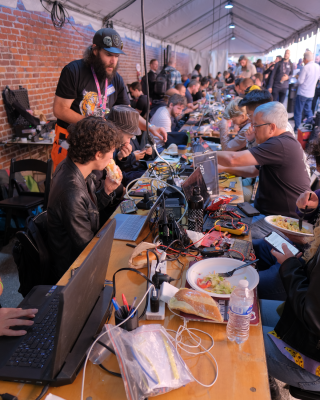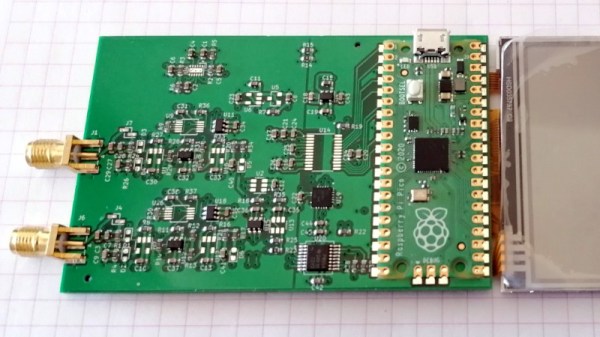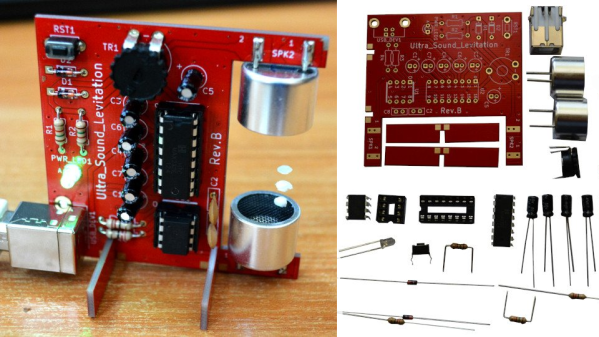One of our favorite musical hackers, [Look Mum No Computer] is getting dangerously close to building a computer. His quest was to create a unique drum machine, inspired by a Soviet auto-dialer that used rope core memory for number storage. Rope memory is the read-only sibling to magnetic core memory, the memory technology used to build some beloved computers back in the 60s and early 70s. Rope core isn’t programmed by magnetizing the ceramic donuts, but by weaving a wire through them. And when [Look Mum] saw the auto-dialer using the technology for a user-programmable interface, naturally, he just had to build a synth sequencer.
Continue reading “Rope Core Drum Machine”
Day: November 6, 2022
Recycled Chairs Bring The Subway To Your Living Room
Public transit seats have a rough life. Enduring a number of wear cycles that would make your sofa weep, they take a beating and have to keep looking presentable. When trains and buses are retired, where do the old seats go? A team from the MIT Hobby Shop investigated what was happening to the seats from retiring MBTA Red Line cars and recycled them into stylish chairs.
After some sleuthing and many emails, the MBTA relinquished a number of old subway seats to the team. Since the subway seats didn’t have legs, wood from old church pews was used to create bases. It took one pew end support to create each set of legs, which were cut out on a bandsaw. The old dark stain was sanded off, and the bases were finished with three coats of gel topcoat, letting the natural beauty of the old oak shine through.
We love seeing old things given new life here at Hackaday. If you want to see some more recycled furniture, check out this tire table, this upcycled jeans chair, or these best practices for making box forts.
Hackaday Links: November 6, 2022
Remember the chip shortage? We sure do, mainly because as far as we can tell, it’s still going on, at least judging by the fact that you can’t get a Raspberry Pi for love or money. But that must just be noise, because according to a report in the Straits Times, the chip shortage is not only over, it’s reversed course enough that there’s now a glut of semiconductors out there. The article claims that the root cause of this is slowing demand for products like smartphones, an industry that’s seeing wave after wave of orders to semiconductor manufacturers like TSMC canceled. Chips for PCs are apparently in abundance now too, as the spasm of panic buying machine for remote working during the pandemic winds down. Automakers are still feeling the pinch, though, so much so that Toyota is now shipping only one smart key with new cars, instead of the usual two. So there seems to be some way to go before balance is restored to the market, but whatever — just call us when Amazon no longer has to offer financing on an 8 GB Pi.
A Pi Pico Oscilloscope
At the budget end of the oscilloscope range lie the so-called pocket ‘scopes. About the size of a deck of cards, they combine a microcontroller and an LCD screen to make an instrument with a bandwidth in the tens of kilohertz and a not-too-sparkling performance. They’re something of a toy, but then again, if all that’s needed is a simple ‘scope for audio frequencies, they make a passable choice in a small package. Now [jgpeiro] has made one which is light years ahead of the toy kits, using a Raspberry Pi Pico, a 100 MHz ADC, and an effort to design a better input circuit.
At its simplest this could be a straightforward op-amp and ADC circuit feeding the Pico, but instead it has multiple stages carefully designed to offer the full bandwidth, and with gain, offset, and trigger settings being set by a series of DAC chips under software control. This and the decent bandwidth make this a much more viable oscilloscope, and one we’d like to see further developed.
By comparison, we took a look at the best of the competition a few years ago.
Conducting Plastic Can Replace Metal
The University of Chicago has announced they have created a material that behaves like plastic but conducts like metal. They also say they don’t fully understand why it works yet. Usually, good conductors like metals have very orderly atomic structures, something that plastics tend not to have.
The material is based on nickel, carbon, and sulfur. The resulting material was conductive and stable. However, the atomic structure isn’t orderly like a traditional conductor.
Mini Ultrasonic Levitation Kit Is An Exercise In Sound Minimalist Design
For those that haven’t heard, ultrasonic levitation is a process by which two or more ultrasonic transducers are set opposite to each other and excited in such a way as to create a standing wave between them. The sound is, as the name implies, ultrasonic — so outside the range of human hearing — but strong enough so that the small, light objects can be positioned and held fixed in mid-air where there’s a pressure minimum in the standing wave. [Olimex] has created a small ultrasonic levitation kit that exemplifies this phenomena.
The kit itself is made using through-hole components, with an ATTiny85 as the core microcontroller to drive two TCT40-16T ultrasonic speakers, and a MAX232 to provide a USB interface drives the transducers (thanks to the folks in the comments for the correction). Two slotted rectangular PCB pieces that solder connect to the main board, provide a base so that the device stands upright when assembled. The whole device is powered through the USB connection, and the ultrasonic speakers output in the 40KHz range providing enough power to levitate small Styrofoam balls.
The project is, by design, an exercise in minimalism, providing a kit that can be easily assembled, and providing code that can be easily flashed onto the device, examined and modified. All the design files, including the bill of materials, KiCAD schematics, and source code are provided under an open source hardware license to allow for anyone wanting to know how such a project works, or to extend it themselves, ample opportunity. [Olimex] also has the kit for sale for those not wanting to source boards and parts themselves.
We’ve featured ultrasonic levitation devices before, from bare bones system driven by a NE555 to massive phased arrays.
Supercon Sunday: Check The Live Stream
Supercon is entering the final phase: it’s Sunday! But it’s not over yet: there is a phenomenal lineup of talks today, starting at 9:30 AM PST, and we’re streaming the main stage live from the very beginning until the badge-hacking awards ceremony at 5:30 pm. And if you’d like to join in the conversation, head over to the Hack Chat or the Discord.
 We kicked off Friday with a full day of badge hacking, workshops, food, drink, and music. What used to be a late-afternoon pre-registration has grown into the early morning hours, and gave people a great opportunity to catch up after two years of remote mode.
We kicked off Friday with a full day of badge hacking, workshops, food, drink, and music. What used to be a late-afternoon pre-registration has grown into the early morning hours, and gave people a great opportunity to catch up after two years of remote mode.
Saturday was full-on Supercon, and the talks were phenomenal. We recorded interviews, took tons of photos, and of course recorded the talks given on the DesignLab stage, and we’ll be getting those out to you over the next weeks. (It’s a lot.)
In addition to all the talks, we announced the winners of the 2022 Hackaday Prize! It was a big year for small-scale energy generation and recycling, and all of the winning projects were clever, well tested, and easily replicable. Check them out.
So now that you’re all caught up, settle in for a jam-packed Sunday. See you in the livestream if not in real life!


















